Contents
- Cultural policy
- Books, libraries and archives
- Cinema and the stage arts
- Visual arts
- Protection and promotion of the Cultural Heritage
- Sports policy
- Links
Cultural policy
Distribution of responsibilities in culture
Article 44.1 of the Spanish Constitution provides that public authorities shall promote and oversee access to culture, to which all are entitled.
Article 149.2 of the Constitution provides that, without prejudice to the competences that may be assumed by the regional governments, the State shall consider the promotion of culture a duty and an essential function and shall facilitate cultural communication among the regional governments, in cooperation with them. There is therefore a non-exclusive co-existence of State and regional competences in the matter of culture.
At the same time, Article 149.1 of the Spanish Constitution provides that central government has exclusive competence over the following matters:
- Legislation on copyright and industrial property
- Protection of the Spanish cultural and artistic heritage and national monuments against exportation and plunder
- Museums, libraries and archives belonging to the State, without prejudice to their management by the regional governments
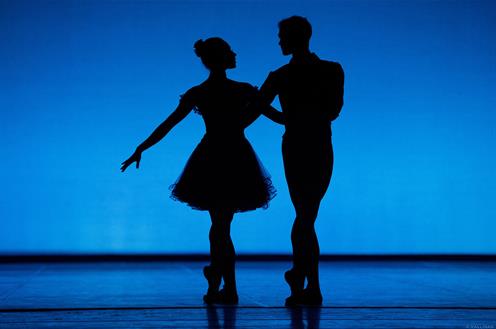 Compañía Nacional de Danza, Delibes Suite (Ministerio de Educación, Cultura y Deporte)In accordance with the division of competences laid down by the Constitution, and by virtue of Royal Decree 1823/2011, of 21 December, restructuring the ministerial departments, it is the responsibility of the Ministry of Education, Culture and Sport to promote, protect and disseminate historical Spanish heritage, State museums and the arts, books, reading and literary creation, cinematographic and audiovisual activities and books and State libraries, and to promote and disseminate culture in Spanish, as well as strengthening cultural cooperation and international relations in cultural matters, in coordination with the Ministry of Foreign Affairs and Co-operation.
Compañía Nacional de Danza, Delibes Suite (Ministerio de Educación, Cultura y Deporte)In accordance with the division of competences laid down by the Constitution, and by virtue of Royal Decree 1823/2011, of 21 December, restructuring the ministerial departments, it is the responsibility of the Ministry of Education, Culture and Sport to promote, protect and disseminate historical Spanish heritage, State museums and the arts, books, reading and literary creation, cinematographic and audiovisual activities and books and State libraries, and to promote and disseminate culture in Spanish, as well as strengthening cultural cooperation and international relations in cultural matters, in coordination with the Ministry of Foreign Affairs and Co-operation.
The Sectoral Conference on Culture is the body through which the central government cooperates with the regional governments in the matter of culture. Its aim is to develop coordinated action in this area, in line with the principles of institutional loyalty, cooperation and mutual respect in the exercise of the competences that these tiers of government have attributed to them.
In addition, the Council of St James is the body that organises cooperation with the aim of facilitating communication between the central government and the regional governments with respect to the Camino de Santiago [Way of St. James] (the Basque Country, Catalonia, Galicia, the Principality of Asturias, Cantabria, La Rioja, Aragon, Navarre and Castile-Leon) for the purpose of coordinating and collaborating on the programmes and actions that are planned in relation to the protection and restoration of the Camino and the organisation of St James' Holy Years.
Other bodies through which cooperation is carried out are:
- The Historical Heritage Council: a body that assists in cooperation between central government and the regional governments with the essential aim of facilitating communication, alongside the exchange of action and information programmes related to Spanish Cultural Heritage.
- The State Council for the Stage Arts and Music: a participatory and advisory body that is part of the National Institute of Stage Arts and Music (hereinafter, INAEM), in the area of stage arts and music.
- The Council for Inter-Library Cooperation: a body that channels cooperation between public libraries.
- The Council for Inter-Archive Cooperation: the joint body for cooperation between public authorities in the matter of archives, forming part of the State Secretariat for Culture.
European Union - Creative Europe
Article 167 of the Treaty on the Functioning of the European Union defines cultural action within the framework of the European Union, through the Education, Youth, Culture and Sports Councils.
Creative Europe is the new EU programme for 2014-2020 aimed at boosting the cultural and creative sectors (cinema, TV, stage and visual arts, design and applied arts, music, literature, the material and intangible cultural heritage and other similar areas).
It includes the previous MEDIA and Culture 2007-2013 programmes, and now also incorporates a cross-sectoral strand, which includes a financial guarantee instrument and other initiatives, above all:
- The European Capitals of Culture
- The Seal of the European Label.
- European prizes for Literature, Architecture, Cultural Heritage, Cinema and Rock & Pop Music.
At the request of the European Commission's Directorate General for Education and Culture, a service officially known as 'Europa Creativa Desk - Oficina Cultura' has been set up within the Ministry of Education, Culture and Sport. Its function is to spread information and provide advice to cultural operators who may be beneficiaries of calls for proposals under the Culture Sub-programme, within the Creative Europe Programme.
Books, libraries and archives
Books in Spain
Spain has a long list of writers with books published by publishing houses and spread by distributors through 30,000 points of sale, of which 4,336 are independent booksellers.
A total of 524,213 titles are circulated within this network, with an annual average of 76,400 new published works, which with an average of 3,223 copies per title, gives a total production of 246.3 million copies per year (around 675,000 copies per day), according to the Report on the Book Trade in Spain 2013 by the Federation of Publishers' Associations in Spain in collaboration with the Ministry of Education, Culture and Sport.
This production and distribution network has a turnover of 526.48 million euros abroad and over 2.18 billion euros on the domestic market.
The world of books in Spain includes books in Spanish and all the country's co-official languages. Of all book production (in all the languages of Spain), 85.4% is in Spanish and the rest in the other languages, with Catalan (at 9.6%) the next most important, according to the Overview of Data on Spanish Book Publishing 2013, issued by the Ministry of Education, Culture and Sport. Publishing production is strongly concentrated geographically, given that Madrid and Catalonia account for 67.7% of Spain's total.
Libraries
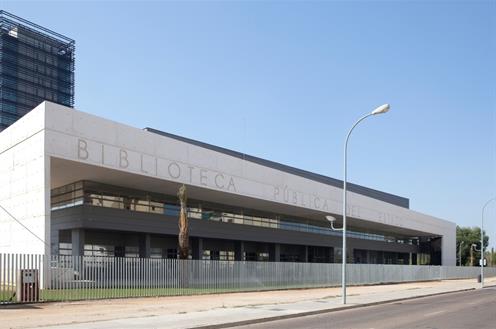 Biblioteca Pública del Estado en Badajoz (Ministerio de Educación, Cultura y Deporte)The 53 State Public Libraries (Spanish acronym: BPE) are centres of great importance in terms of the cultural development of the country and citizen access to information. They make up the most important of the library networks in Spain, due to their presence across the whole country, the volume of their funds, the scope of their users and services and the wealth of their bibliographic heritage. All this makes these libraries centres of particular importance for the country's cultural development and for citizen access to information. These 53 centres received 18,617,567 visits in 2013, of which 14,880,115 were in person and 4,741,123 online. They have 11,699,438 bibliographical documents of all kinds and have incorporated 374,101 documents into their collections. A total of 587,235 people used the lending service, which made 8,790,336 loans; and 2,035,472 Internet sessions were recorded, with 9,900,901 catalogue consultations.
Biblioteca Pública del Estado en Badajoz (Ministerio de Educación, Cultura y Deporte)The 53 State Public Libraries (Spanish acronym: BPE) are centres of great importance in terms of the cultural development of the country and citizen access to information. They make up the most important of the library networks in Spain, due to their presence across the whole country, the volume of their funds, the scope of their users and services and the wealth of their bibliographic heritage. All this makes these libraries centres of particular importance for the country's cultural development and for citizen access to information. These 53 centres received 18,617,567 visits in 2013, of which 14,880,115 were in person and 4,741,123 online. They have 11,699,438 bibliographical documents of all kinds and have incorporated 374,101 documents into their collections. A total of 587,235 people used the lending service, which made 8,790,336 loans; and 2,035,472 Internet sessions were recorded, with 9,900,901 catalogue consultations.
As part of the process of ongoing modernisation and improvement of the library infrastructure, work on constructing and fitting out the new buildings such as the State Public Libraries in Ceuta and Girona was completed during 2013 and 2014, to be added to those recently opened in Badajoz and Burgos. The State Public Library in Segovia is expected to be opened in 2015.
Of note is the launch of the eBiblio project by the ministry in collaboration with the regional governments. The aim of this digital book lending service is to extend reading to people in electronic format and thus promote the legal use of digital content.
Also in relation to digital content, the creation of digital libraries is another area of great cultural and economic interest that should not be forgotten. Its development is promoted and supported by European Union initiatives. The most significant Spanish exponent of activity in the area of libraries and digitisation is Hispana, a common access point to all Spanish digital or online libraries. In 2015, it provides access to more than 5 million digital publications in 208 Spanish databases or depositories. Spanish libraries participate in international cooperation initiatives in the area of digital libraries, among them Europeana (European aggregator of digital content and free-access European digital library). Up to 2015, Hispana has contributed 2.2 million items of digital content.
The Spanish National Library (Spanish acronym: BNE)
In 2014, the BNE published the document 20-BNE-20. It sets out a roadmap for the Spanish National Library for the upcoming years, a new stage of its existence when a renewed, responsive, dynamic and easily accessible BNE will have its own law and charter at the heart of the structure formed by the major institutions in the country.
2015 was a year in which major events took place affecting the BNE. One of the most important was the approval of the Law 1/2015, of 24 of march, regulating the National Library of Spain. Its entry into force meant its recognition as an essential institution for Spanish culture and the strengthening of its leading role among Spanish libraries.
The new legal regulation, which will continue to maintain its classification as an independent body under the umbrella of the Ministry of Education, Culture and Sport, grants its recognition as an essential institution for our culture and underpins its mission as a guarantee of the preservation of the cultural identity of our country.
This grants the institution a new framework that will enable its adaptation to a new, faster and more flexible management model in accord with its functions and will enable it to use its resources in a more effective manner and hence ensure its maximum efficacy as a public service.
This amounts to recognition of an institution that has gone from providing on-site and limited access to allowing open, free and democratic access to our bibliographic and documentary heritage, thus guaranteeing its digital access and conservation.
This law has been designed for future researchers, who will need to go online to view information with content that would not exist if the National Library of Spain did not save these archives as the body entrusted with the conservation and transmission of our digital heritage. To this end, a royal decree has been approved for the legal deposit of online publications.
This law assigns a special value to the National Library of Spain as a centre for the promotion of research on our culture and which considers the generation of knowledge as an essential value for improving societies. It will also allow for the tremendous potential of the National Library of Spain to be harnessed with a view to enriching cultural life in Spain.
The text of the law on the National Library of Spain includes a renewal of its mandate which inspired its foundation: to preserve the bibliographic and documentary heritage of Spain and make it available to all citizens, whilst adapting it to the digital era and hence to the new management needs that provide the response demanded by society from this institution - an institution that guarantees the cultural identity of our country.
Furthermore, in 2015, an ambitious cataloguing and digitisation plan was implemented. The celebration in 2016 of the 400th anniversary of the death of Miguel de Cervantes makes the cataloguing of works related to the author an absolute priority. The Spanish National Library holds the best collection in the word of material related to Cervantes, making it an international reference point for studies on the writer.
Another of the priorities is the coordination and management of the Electronic Legal Deposit to ensure compliance and preserve the content of Spanish websites.
The BNE will continue to work on standardising its catalogues, as it has been doing in recent years, particularly in revising all the cataloguing rules that can bring us into line with the rules followed by similar countries.
The BNE is also present in international projects related to the technical process, with the creation of databases of authorities, with cross-referenced data, etc. in which standardisation plays a fundamental role.
The policy of promoting the reuse of public information through improvement and continuity of Datos.bne will be continued, and it will be opened up to participation from other institutions.
The major data sets generated by the BNE will be incorporated into the Plan for the Reuse of Information in the Public Sector (Spanish acronym: RISP) with the aim of promoting the creation of bibliographic catalogues and unique digital libraries.
The master plan to digitise the BNE's own collections will focus on the digitisation of the collections of works related to Cervantes, as well as continuing the digitisation of the historic Spanish press. The work of Spanish authors within the public domain will also be the object of digitisation.
Cultural activity, and thus the opening up of the BNE to all citizens, will continue through its programming of exhibitions and activities, of particular note among them are the following:
- Exhibitions: Cervantes-related collections in the BNE: from Doctor Thebussem to the Sedó fund; Saint Teresa of Avila, the Proof of my Truth; Looking at Architecture; Vicente Carducho; Photographs of Monuments from the 19th Century; Spanish Calligraphy; the art of Writing; Rubens and the Golden Age of Flemish and Dutch Engraving.
- Cultural activities including the Stage Transfusions cycles: Domestic Uses of Words Here and Now; Women in the Cinema; and Books, books, books... , as well as the typical conferences and panel discussions related to the exhibitions held, book presentations and participation in cultural events of a national scope.
Equally, the BNE Museum will continue the educational programme and activities for all publics.
State Archives
The State Archives are also immersed in a process of modernisation, in which the key element is the digitisation of documentation to make it available for all the public online. The process of digitising documentary material (archive and bibliographic) of the Ministry of Education, Culture and Sport improves the access and conservation of Spanish heritage, in coordination with other institutions, through participation in international projects such as APEx (Archives Portal Europe) and Europeana.
The outstanding Spanish project for the digitisation of documentation - the Spanish Archives Portal (Spanish acronym: PARES) - currently has 5,999,820 descriptive registers online with 33,287,115 document images, which in 2014 received a total of 988,562 individual users, who consulted around 22.8 million pages. These figures give some reflection of the importance of this platform.
For 2015, the main novelty will be the incorporation of a new version of PARES, planned for the middle of the year, with significant new technological and documentary features that will allow not only the consultation of traditional documentary material, but also major audiovisual funds from the State Archives, access to this heritage of global importance through mobile devices and the possibility of querying the system in any of the co-official mainland languages, as well as in English and French. The new version will also allow consultation of important private archives and documents that receive State aid and subsidies, which will be accessible online through the "Archivos Privados" [Private Archives] website.
Royal Decree 1708/2011, of 18 November, establishing the Spanish Archive System and regulating the Archive System of the General State Administration and its public bodies and the system of access to it began to be developed in January 2012. Its enactment, in response to demand from various sectors, has tried to fill a legal void and has updated a State sector-based regulation that dated back to 1901. It meets requests from people to have documentary information available through a public authority in which the presence of new technologies has led to a diametrically opposed reality.
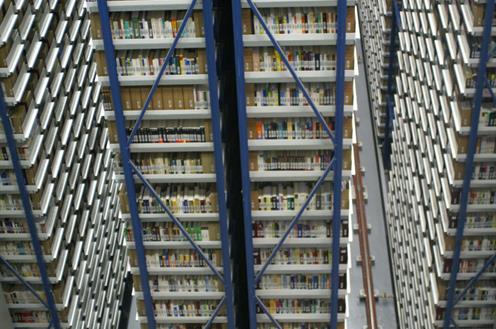 Libros almacenados en la Biblioteca Nacional de España (Ministerio de Educación, Cultura y Deporte)The new law created the Archive Cooperation Council, part of the State Secretariat for Culture, as a meeting point and a forum for voluntary collaboration between the different public authorities with competences in the area of archives, and an essential instrument of the Spanish Archive System. The Royal Decree will also organise the Archive System of the General State Administration and its public bodies with the aim of establishing a common set of rules for managing a modern, orderly and efficient system of archives based on a concept of public service. The Archive Council of the General State Administration has been created as an inter-ministerial body attached to the Ministry of the Presidency, and greater thought has been given to the electronic documents generated by the Public Administration Services. Finally, the Royal Decree has created the Historic Archive of the Nobility, with its headquarters in Toledo, which will integrate the former Nobility Section of the National Historical Archive, which is being closed down and whose legal remit is expected to be repealed in 2015.
Libros almacenados en la Biblioteca Nacional de España (Ministerio de Educación, Cultura y Deporte)The new law created the Archive Cooperation Council, part of the State Secretariat for Culture, as a meeting point and a forum for voluntary collaboration between the different public authorities with competences in the area of archives, and an essential instrument of the Spanish Archive System. The Royal Decree will also organise the Archive System of the General State Administration and its public bodies with the aim of establishing a common set of rules for managing a modern, orderly and efficient system of archives based on a concept of public service. The Archive Council of the General State Administration has been created as an inter-ministerial body attached to the Ministry of the Presidency, and greater thought has been given to the electronic documents generated by the Public Administration Services. Finally, the Royal Decree has created the Historic Archive of the Nobility, with its headquarters in Toledo, which will integrate the former Nobility Section of the National Historical Archive, which is being closed down and whose legal remit is expected to be repealed in 2015.
The inclusion in the UNESCO Memory of the World Register in 2013 of the "Decreta of Leon of 1188", the oldest documentary testimony known of what, at the threshold of contemporary society, would become known as the European parliamentary system, the "Llibre del Sindicat Remença" (1448), and the documents and materials related to the Keicho Mission to Europe (1613-1620), a proposal made jointly with Japan, which constitute an excellent testimony of the cultural importance of the documentary heritage that is housed by the Spanish archives and the international prestige it deserves. The Treaty of Tordesillas was added to the Memory of the World Register in 2007 and the Santa Fe Capitulations in 2009; and 2015 could see the addition of the "Vocabularies of 35 indigenous languages of America and Asia translated to Spanish in the 18th Century", the "Sent Sovi" (one of the first documentary descriptions of European cooking in mediaeval times), and "The Manuscripts of the Commentary on the Apocalypse (Beato de Liebana) in the Iberian Tradition". These candidates were presented in the call for proposals in 2014, the last of them in collaboration with the Portuguese State Secretariat for Culture, for inclusion on the select list of documentary items considered of worldwide importance.
In addition to these UNESCO recognitions, in 2015 the IBERARCHIVOS-ADAI Programme (Support for the Development of the Ibero-American Archives), is a candidate for the UNESCO/Jikji Memory of the World Prize. IBERARCHIVOS is a Spanish initiative for cooperation and integration among Ibero-American countries, organised and ratified by the Ibero-American Summits of Heads of State and Government, to promote access, organisation, description, conservation and dissemination of the documentary heritage that contributes decisively to consolidating the Ibero-American Cultural Space. In operation for 15 years, the IBERARCHIVOS-ADAI Programme is the main regional programme for archive cooperation. The programme creates incentives for strengthening links of solidarity and boosts the capacities of professionals and the promotion of Ibero-American archives of any type, from general national archives to municipal archives and Human Rights institutional archives or those of indigenous peoples, among others.
Cinema and the stage arts
Cinema
In cinema, 2014 was a year of extraordinary results for Spain, which was the European Union country where cinema ticket sales increased most. With more than 132 million euros of revenue, over 22 million cinemagoers and a market share of 25.5%, the Spanish cinema industry has achieved the best box office in its history according to consolidated statistics. One of the keys to this success was the involvement in production by public and private television channels.
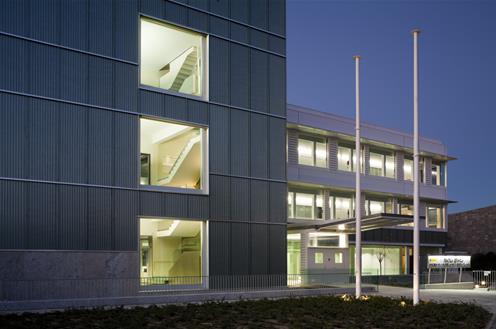 Centro de Conservación y Rehabilitación de la Filmoteca Española (Ministerio de Educación, Cultura y Deporte)In terms of volume of production, with 224 feature films produced in 2014, Spanish cinema is still among the five biggest in Europe, with France, Germany, the UK and Italy. The performance by Spanish cinema in the international markets shows the consolidation of its path of growth, amounting takings around the world of more than 187 million euros and recording more than 23 million spectators over the course of the year.
Centro de Conservación y Rehabilitación de la Filmoteca Española (Ministerio de Educación, Cultura y Deporte)In terms of volume of production, with 224 feature films produced in 2014, Spanish cinema is still among the five biggest in Europe, with France, Germany, the UK and Italy. The performance by Spanish cinema in the international markets shows the consolidation of its path of growth, amounting takings around the world of more than 187 million euros and recording more than 23 million spectators over the course of the year.
The Cinema Protection Fund has maintained its level of commitment, taking into account the adjustments due to the current budget situation. To ease these affects, a system of more efficient tax incentives has been introduced for cinema with the aim of attracting additional investment to the sector.
Among the challenges pending are the need to improve the model of cinema financing to make it more sustainable, and to promote joint productions and the promotion of shooting in Spain, by looking, for example, for synergies with the policy for promoting tourism in the country.
Theatre
Of particular note in this area is the publicly-run Spanish Network of Theatres, Auditoriums, Circuits and Festivals in the different autonomous regions. It now has over 140 associates with performance venues across the whole country.
Also worth mentioning is the recovery of the classics of the Spanish Golden Age. Two factors in recent years have brought the classics back to their rightful place: the International Classical Theatre Festival of Almagro and the National Classical Theatre Company, whose headquarters in the Teatro de la Comedia is expected to be up and running again in the last quarter of 2015.
In 2015, a second edition of the PLATEA Programme will be launched. This involves moving theatrical productions to spaces run by local authorities, with the aim of boosting a sector that has been particularly affected by the crisis. With respect to links with Latin America, initiatives such as the IBERESCENA Programme contribute to boost and consolidate a common theatrical tradition and encourage exchanges between creators and the public on both sides of the Atlantic. Finally, the work of creative centres, theatre's R&D, should also not be forgotten, including La Alhóndiga in Bilbao, La Caldera in Barcelona and Matadero in Madrid.
Dance
Thanks to public and private support, the progress of dance in Spain has extended to all genres and areas, with initiatives such as the General Dance Plan 2010-2014, the State Programme for Circulation of Theatrical Art Productions in Local Authority Venues (Spanish acronym: PLATEA) and circuits such as Danza a Escena (into its 5th year in 2014), the circuit organised by Coordinadora de Salas Alternativas (which had its 12th year in 2014) and the Dance Festivals in non-conventional venues, organised by Asociación A Cielo Abierto (the first was held in 2014).
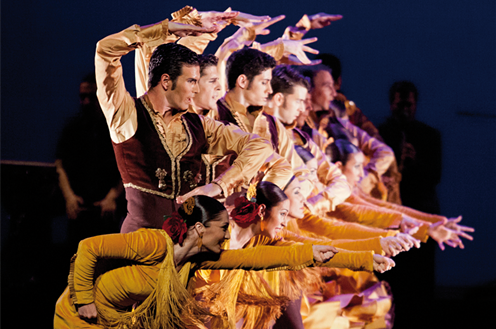 Suite Sevilla, Ballet Nacional de España (Ministerio de Educación Cultura y Deporte)The dissemination of dance uses new technologies through sites such as Danza.es, the dance portal in Spain, and the Music and Dance Documentary Centre.
Suite Sevilla, Ballet Nacional de España (Ministerio de Educación Cultura y Deporte)The dissemination of dance uses new technologies through sites such as Danza.es, the dance portal in Spain, and the Music and Dance Documentary Centre.
Choreographic centres also contribute to the spread of dance, with key exhibition platforms of international renown such as the Mercat de les Flors in Barcelona and the Madrid en Danza festival.
Circus
The reopening of Teatro Circo Price and other circus-theatres, as well as the Resolution of the European Parliament in 2005 calling on the European Commission and Member States to consider the circus as part of European culture, combine with the effort s from circus professionals who work in different companies and centres of creation and the acceptance of the public, with nearly four million spectators every year in Spain.
The most important circus festivals in Spain, such as the Festival of Albacete, the City Of Figueres International Circus Festival and the Fira de Circ Trapezi in Reus (National Circus Prize 2012) form bonds between artists and the public, supporting new creation and showing the most innovative international spectacles in our country.
Music
Spain has an extensive musical tradition, which covers a great diversity of styles. The National Centre for the Promotion of Music aims to reflect this diversity by programming ancient, classical and contemporary music of the best quality across the whole of Spain, in collaboration with other institutions.
State support is also in evidence in public productions (through organisations such as the Spanish National Orchestra and Chorus, the Teatro de la Zarzuela, and the Spanish National Youth Orchestra) as well as finance for projects as varied as the Cuenca Religious Music Week, the Granada International Festival of Music and Dance, the seasons at the Teatro Real, the Gran Teatro del Liceo and the Teatro de la Maestranza, the San Sebastian Musical Fortnight and the Santander International Festival.
With respect to new music, in recent years there has been outstanding work by the Circuito Girando por Salas (into its 6th year in 2015) and the platform for the internationalisation of contemporary Spanish music, Sounds From Spain (with the collaboration of ICEX Spain).
Flamenco is also very active, supported through initiatives such as the Festival Cante de las Minas and the Jerez Festival.
Visual arts
The emergence of spaces for contemporary art created by public authorities has been a feature of recent decades. It has now taken a step towards a period of greater maturity.
Our country has more than 500 spaces or venues for contemporary art across all the autonomous regions. Together with them, civil society and the professional sector have for a number of years organised into collectives and associations and created a structure, that is less visible but no less important, of independent spaces for art, and alternative centres and rooms, making Spain a key hub for contemporary art.
As part of its promotion and support activity, the State Secretariat for Culture contributes to the generation of a more dynamic and innovative backdrop for these forms of expression, supporting our creators through a variety of awards. Among them is the Velázquez Prize, which is for the lifetime work of a creator in the visual arts. It rewards an outstanding contribution to Ibero-American culture. It also awards National Prizes for Visual Arts and Photography.
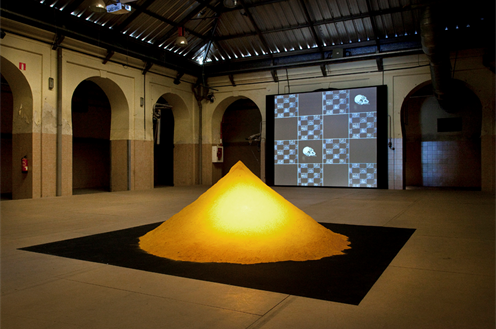 Promoción del Arte en Tabacalera (Paco Gómez, Ministerio de Educación, Cultura y Deporte)The promotion of new creative artists also takes place through temporary exhibitions, in museums and at the Tabacalera venue. Tabacalera, the former Tobacco Factory of Madrid, is a building managed by the Ministry of Education, Culture and Sports since 2003. It has consolidated its position as a model example of participative and sustainable cultural management, which now enjoys broad recognition not only for its exhibitions, but also for other activities such as conferences, workshops, encounters with artists and curators, social forums and creative activities open to the general public, which has made it a model for critical discussion.
Promoción del Arte en Tabacalera (Paco Gómez, Ministerio de Educación, Cultura y Deporte)The promotion of new creative artists also takes place through temporary exhibitions, in museums and at the Tabacalera venue. Tabacalera, the former Tobacco Factory of Madrid, is a building managed by the Ministry of Education, Culture and Sports since 2003. It has consolidated its position as a model example of participative and sustainable cultural management, which now enjoys broad recognition not only for its exhibitions, but also for other activities such as conferences, workshops, encounters with artists and curators, social forums and creative activities open to the general public, which has made it a model for critical discussion.
Access by the general public to artistic content and education of artistic sensitivity are priority objectives. This is the reason behind the creation of Promovídeo, where users can find all the audiovisual items generated by our exhibition policy, producing specific content such as La Voz de la Imagen (The Voice of the Image), interviews with Spanish photographers; Oral memories, the portal of audiovisual interviews with emerging creators; and travelling visual literacy workshops for children, as well as other specific initiatives for young people to encourage social interest and an understanding of contemporary art.
State museums
In the area of museum cultural policy, the renewal of the State museums has continued. In 2014, the level of activity designed to improve the infrastructures of the State museums has continued, prioritising the execution of smaller-scale work and equipment, drawing up architectural and exhibition projects, and above all completing actions initiated in previous years. Of particular significance in this respect is the completion and opening to the public of the National Archaeological Museum, which opened its doors on 1 April 2014. Improvement work has also begun in a number of areas, notably on the 5th refitting and extension phase of the Museum of Fine Arts in Valencia, which is scheduled for completion in 2016. In addition, exhibition spaces are being built in various museums that will allow their opening to the public in 2015. Among them are the Museum of Malaga in the Palacio de la Aduana, the Museum of Pilgrimages and St James in the former Bank of Spain in Santiago and the Museum of Majorca in the Palacio Ayamans.
The works carried out in 2014 with respect to the cultural heritage recovered from the frigate Nuestra Señora de las Mercedes are a fine example of a model of institutional collaboration. Some examples of the way the importance of this heritage has been brought to public notice for purposes of education and raising awareness and in order to guarantee its protection include: the extension of the permanent exhibition in the National Museum of Underwater Archaeology ARQUA, with a new model dedicated to ocean navigation, where recovered archaeological finds hold pride of place; the creation of an online portal that brings together all the information about the recovery of material used, the history of the frigate and the action plan for this cultural heritage drawn up by the State Secretariat for Culture; and the successful exhibition "The Last Journey of the Frigate Nuestra Señora de las Mercedes", which has been visited by more than 150,000 people in the National Archaeological Museum.
The Permanent Laboratory for the Museum Public is a project that aims to increase information on what the public wants in order to improve the management of museums and the satisfaction of public demand. Throughout 2014, it has continued to work on extending the knowledge of visitors to these institutions. Reports have been prepared on the profiles of visitors to the Cerralbo Museum, Museum of Romanticism and the El Greco Museum, and to the Lázaro Galdiano Foundation Museum (incorporated by special agreement to the project).
It should be noted that the State museums have demonstrated that the cultural offering they make available to the public is becoming increasingly popular: this is reflected in the figures of visitors in 2014, which increased very significantly on the previous year, by nearly 50%, from 1,927,250 visits in 2013 to 2,860,615 in 2014. Among the reasons for this has been the reopening of the National Archaeological Museum and the visitors to the El Greco Museum and the Sephardic Museum in Toledo as a result of the 4th centenary of El Greco.
Finally, the State museums aim to be institutions that are more socially committed and responsible. To do so, the Museos+Sociales Plan launched in 2015 with the twin objective of giving the many actions that museums are developing in this area more visibility and to open up new lines of work aimed at groups that are currently not represented among museum visitors.
El Prado National Museum
The Prado National Museum currently has around 1,480 works on show in the building designed by Juan de Villanueva to house a natural science museum, which, since its opening in 1819 as the Royal Museum of Painting and Sculpture, has been the object of various expansions, the most notable being that undertaken by the architect Rafael Moneo between 2001 and 2007.
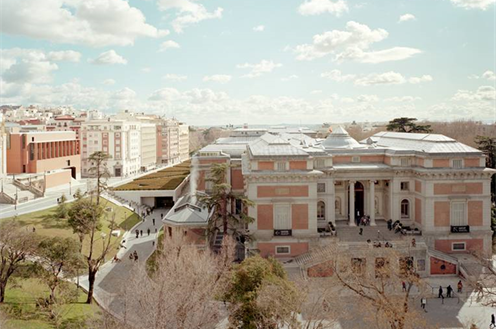 Museo Nacional del Prado (Francesco Jodice, Museo Nacional del Prado)In all these years, the Prado Museum's collection has significantly increased. The masterpieces from the royal collections, the source of the current museum's funds, were included into the collections of the Museo de la Trinidad in 1872 and the Museum of Modern Art in 1971, together with significant legacies, donations and purchases.
Museo Nacional del Prado (Francesco Jodice, Museo Nacional del Prado)In all these years, the Prado Museum's collection has significantly increased. The masterpieces from the royal collections, the source of the current museum's funds, were included into the collections of the Museo de la Trinidad in 1872 and the Museum of Modern Art in 1971, together with significant legacies, donations and purchases.
Among the iconic works from the Prado Museum that have made it one of the most famous museums in the world are: "Las Meninas" by Velázquez, "The Family of Charles IV" by Goya; "The Deposition of Christ" by Weyden; "The Garden of Earthly Delights" by Bosch; "Nobleman with his Hand on his Chest" by El Greco; "Charles V at Mühlberg" by Titian; "Christ Washing his Disciples' Feet" by Tintoretto; the "Self-Portrait" by Dürer; and "The Three Graces" by Rubens.
In addition to 1,039 paintings, 215 sculptures and nearly 220 prints, drawings and pieces of decorative arts on permanent exhibition, every year the Museum presents notable exhibitions in its rooms and shows a significant part of its collection outside its headquarters, either in temporary exhibitions, thanks to the Prado Itinerante and Prado Internacional programmes, or in deposits in official museums and institutions, in an effort to bring its artistic heritage not only to the local public and tourists but also to people further away.
The Prado Museum ended 2014 with a 7.65% increase in visitors on the previous year, to 2,536,844. To this figure, should be added more than 400,000 visitors who have enjoyed the temporary exhibitions organised by the museum outside its main buildings in different cities in Spain and abroad.
The Prado Museum has also increased its capacity for self-finance, which now stands at 70% thanks to its own income and generous contributions from corporate benefactors, sponsors and collaborators, which have allowed it to deal with the considerable cut in public funding in recent years without affecting its museum activity, and work to meet the objectives established in the Action Plan for 2013-2016.
Among the temporary exhibitions in the 2014 programme were "'El Greco and modern painting'', which showed the key influence of the artist from Crete in the origins of modern painting. The show was organised for the 400th anniversary of the artist's death, and brought 26 masterpieces by El Greco face to face with over 80 works by key artists from the 19th and early 20th Century. During the 15 weeks it was open to the public, it was visited by a total of 401,774 people.
In 2015, the Prado made some major additions to its collections, notably the "Triptych of the Birth of Jesus" by the Master of the Triptych of Zarzoso, acquired from the Várez Fisa family. This is a work of extremely high quality, and shows the unusual style of this master trained in international Gothic and influenced by Flemish models. Another is the library of Juan Bordes, one of the most important collections in the world specialising in the study of the human figure. It consists of 600 volumes, treaties and drawing books from the 16th to 20th Century, together with which the Museum received a drawing book from the Rubens workshops as a donation.
Reina Sofia Art Centre and National Museum
With a little under two decades in existence, the Reina Sofia Arts Centre and National Museum (Spanish acronym: MNCARS) enshrines a different concept of museum: a space for memory, knowledge, archives, reflection, debate and interpretation.
Its collection is made up of over 20,000 works, ranging from the art of the late 19th Century to the present day. One of its key works is "Guernica" by Pablo Picasso. A broad selection of the work is presented in three main sections: Utopias and Conflicts (1900-1945); Art in a Divided World (1945-1968); and From Revolt to Post-Modernism (1962-1982). Both the Collection and the wide-ranging programme of temporary exhibitions aim to promote critical understanding of contemporary art by the public, as well as the conservation and interpretation of a collective heritage. This is complemented with activities and forums for debate, in which the Museum ventures beyond its geographical limits through multiple collaborative projects with other centres, both Spanish and on the international stage.
A total of 2,673,754 people visited the Museum in 2014 (including both its collection and one of the 16 temporary exhibitions) or participated in one of its activities. The exhibition featuring Richard Hamilton was one of the most popular, with 310,000 visitors.
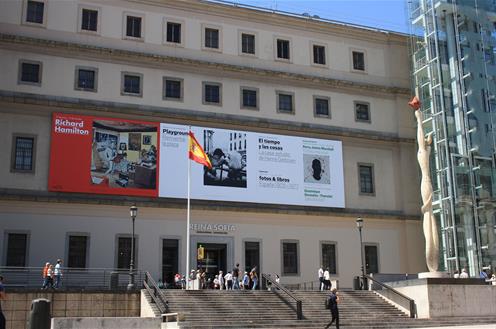 Museo de Arte Contemporáneo Reina Sofía (Ministerio de Educación, Cultura y Deporte)One of the Museum's fundamental strategies is to extend the number of temporary touring exhibitions and promote the collection's resources in museums in Spain and abroad, which at the same time mean a reduction in costs and a significant source of income, as well as constituting a very effective way of making them known to the public. This means that in addition to the total figure of visitors in 2014 we have to add over a million of people who viewed the Museum's exhibitions outside Spain, in institutions such as the Lima Museum of Art, the MUNTREF in Buenos Aires, the Museu Serralves in Oporto, Hangar Bicocca in Milan, MUHKA in Antwerp and the Kunsthal Charlottenborg in Copenhagen. The exhibitions in the collection have included "Inside and Outside: The Two Sides of Spanish Informalism in the MNCARS collections" (Japan), "Late Miró (1963-1981)" (United States) "Salvador Dalí" (Brazil) and "Picasso and Spanish Modernity (1910-1963)" in the Strozzi Palace in Florence.
Museo de Arte Contemporáneo Reina Sofía (Ministerio de Educación, Cultura y Deporte)One of the Museum's fundamental strategies is to extend the number of temporary touring exhibitions and promote the collection's resources in museums in Spain and abroad, which at the same time mean a reduction in costs and a significant source of income, as well as constituting a very effective way of making them known to the public. This means that in addition to the total figure of visitors in 2014 we have to add over a million of people who viewed the Museum's exhibitions outside Spain, in institutions such as the Lima Museum of Art, the MUNTREF in Buenos Aires, the Museu Serralves in Oporto, Hangar Bicocca in Milan, MUHKA in Antwerp and the Kunsthal Charlottenborg in Copenhagen. The exhibitions in the collection have included "Inside and Outside: The Two Sides of Spanish Informalism in the MNCARS collections" (Japan), "Late Miró (1963-1981)" (United States) "Salvador Dalí" (Brazil) and "Picasso and Spanish Modernity (1910-1963)" in the Strozzi Palace in Florence.
In compliance with the Law regulating the Museum and the implementation, starting in 2013, of its new Charter, in March 2014 the Reina Sofia Museum approved a General Action Plan for the period between 2014 and 2017, which implements new strategies both in the general scheme of cultural management and in the specific context of contemporary art. Within this framework, the Museum will continue to work to develop an efficient organisation that will optimise its management mechanisms and continue to increase its capacity for self-finance, which between 2011 and 2014 increased by around 200% from 4.03 million euros to 8.02 million euros.
Since its creation in 2013, the Reina Sofía Museum Foundation has acted as an efficient tool in which different sectors of civil society at an international level, geared particularly to Latin America, collaborate in the Museum's activities, applying new forms of support, patronage and sponsorship. This role in supporting the Museum ranges from protection of the heritage, extension of the collection and the concept of a shared heritage, to the promotion and spread of knowledge and education and the defence of a common archive as a fundamental element in modern culture.
Protection and promotion of the cultural heritage
Protection of Heritage
Spain has an exceptional and varied cultural heritage. Aware of this, and with the aim of preserving and enriching it, in collaboration with the regional governments and other public and private institutions, the Government of Spain has been carrying out a wide-ranging and systematic policy of research, conservation and restoration for decades, as agreed within the Historical Heritage Council (a body in which the General State Administration collaborates with the regional governments).
In this area, the National Cultural Heritage Plans are conceived as instruments for the promotion of this collaborative policy. From the National Cathedral Plan, approved in 1990, to the Traditional Architecture Plan in 2013, a total of 11 plans have been approved, and work is being carried out on preparing those dedicated to photographic heritage, and to emergencies and risk management of the heritage, which will be published in 2015. These National Plans enshrine the ongoing and comprehensive commitment on the part of the Government of Spain and the regional governments to heritage, which arises from the Convention Concerning the Protection of the Cultural Heritage of the United Nations Organisation for Education, Science and Culture (UNESCO) of 2001 and the integration of our country into the Consultative and Technical Council that coordinates its development and application.
"El último viaje de la Fragata Mercedes", Museo Arqueológico Nacional (Acción Cultural Española)The functions of research and knowledge of the cultural heritage that lie within the competence of the General State Administration, and its conservation, restoration and dissemination, with the aim of protecting the cultural goods and allowing their enjoyment by the general public, are the remit of the Spanish Cultural Heritage Institute (Spanish acronym: IPCE), a body that answers to the Ministry of Education, Culture and Sport. The IPCE is a centre recognised at a national and international level in the disciplines and techniques related to research, conservation and restoration of heritage, also contributing to the documentation and training of professionals in these scientific areas.
The National Underwater Archaeological Heritage Protection Plan, as well as the document implementing it, the Green Book on Underwater Heritage, have great strategic importance in the defence of our cultural heritage. Also worth noting on this front is the recovery after a committed defence of its rights in the US courts, of the plundered cargo from the frigate Nuestra Señora de las Mercedes, which was returned to Spain in February 2012, and whose pieces will be included in the National Underwater Archaeological Museum (ARQUA), a centre of national and international importance in the protection of underwater heritage, based in Cartagena (Murcia). In addition, in 2013 the US courts have ruled that the company Odyssey Marine Exploration has to return the majority of the legal costs to Spain.
Another line of action to reassess our heritage is its international promotion through UNESCO declarations, which the government promotes in the name of all the public administrations. With 44 properties, Spain is the third country with the most properties included on the World Heritage List. Spain ratified the Convention for the Safeguarding of Intangible Cultural Heritage in 2006 and has since been highly active in this area, resulting in 11 expressions registered on the Representative List of Intangible Cultural Heritage and three projects included on the Register of Best Practices for the safeguarding of Intangible Cultural Heritage of Humanity, thus becoming the country with the fourth highest number of recognised elements, together with Croatia.
Promotion of culture abroad
The internationalisation of our culture has boosted the diversity and growth of our cultural industries. This has required a reassessment of the policies promoting culture abroad, within the framework of the European Union and the different specialised international organisations.
With respect to the data on foreign trade in cultural goods, according to the 2014 Annual of Cultural Statistics there was a positive performance of books and the press, with exports of 552.4 million euros and a trade surplus of 230.4 million euros. In 2013, exports of goods linked to culture amounted to 703.4 million euros, compared with imports of 666.9 million euros. The European Union was the main recipient of Spanish exports, at 51.2%, followed by Latin America, at 27.4%.
There are various Spanish cultural agencies around the world: units of the Ministry of Foreign Affairs and Co-operation and of the State Secretariat for Culture, the Cervantes Institute and other specialised cultural bodies (ACE) and non-cultural bodies (ICEX, TURESPAÑA). To this should be added the bodies corresponding to the autonomous regions and the private sector and civil society in their various forms (foundations, associations, entities, companies, etc.).
Spanish action in the area of culture is based on four key elements: promotion of the heritage and dissemination of the most contemporary and diverse expressions of cultural creativity; the internationalisation of cultural and creative industries; intercultural dialogue; and cultural cooperation for development.
Restauración del Castillo de Ucero, Soria (Instituto de Patrimonio Cultural de España)One of the objectives set by the activity of the State Secretariat for Culture in its General Strategic Plan 2012-2015 is "to boost culture as an essential element for the projection of the 'Spain Brand' abroad." Within this framework, there is notable support for the internationalisation of cultural and creative industries. All the stages of the process of production have to be taken into consideration for this: from creation and production (support and promotion of artists) to the marketing of cultural goods and services and their distribution and sale. With the aim of improving the general structures of coordination, a database (INFOX CULTURA) has been created that will provide information on the different actors in cultural activity abroad. The increasing use of information and communication technologies constitutes an essential element for the promotion of culture abroad, the creation of cultural networks and the identification of new processes that lead to the definition of new actions and channels for the internationalisation of culture and its industries.
Intellectual property
Although there are precedents dating back to the 16th Century, the first Spanish law that fully and clearly recognised copyright was published in 1847. Today, in terms of copyright and related rights, Spain is a Party to the Berne Convention, among other international instruments adopted in this area, and has legislation that is constantly being adapted to new realities of the cultural industries, which account for around 4% of GDP. It incorporates the European Union Directives on these rights and respect for them, including matters corresponding to areas such as satellite broadcasting, cable distribution and services in the information society.
Of note in this respect is the recent approval of Law 21/2014, of 4 November, amending both the consolidated text of the Intellectual Property Act and the Civil Procedure Act 1/2000. This 2014 law updates the current legislative framework on Intellectual Property by transposing two European Union Directives (Directive 2011/77/EU on the term of protection of copyright and certain related rights, and Directive 2012/28/EU on certain permitted uses of orphan works), and at the same time updates the system of exemptions and limitations of intellectual property rights, including improvements in the effectiveness of legal mechanisms to protect intellectual property against infringements it may suffer in the digital environment.
The collective administration of rights for use or others relating to ownership corresponds in Spain to eight non-profit entities authorised for this purpose by the Ministry of Education, Culture and Sport; the oldest of which dates back to 1899. These administrative entities are as follows: SGAE (Sociedad General de Autores y Editores) [General Society of Authors and Publishers], CEDRO (Centro español de derechos reprográficos) [Spanish Centre for Reproduction Rights], VEGAP (Visual entidad de gestión de artistas plásticos) [Entity for Management of Visual Artists], DAMA (Derechos de autor de medios audiovisuales) [Audiovisual Media Copyright], AIE (Artistas intérpretes o ejecutantes, sociedad de gestión de España) [Spanish Society for Management of Performers], AISGE (Artistas intérpretes, sociedad de gestión) [Society for Management of Performers], AGEDI (Asociación de gestión de derechos intelectuales) [Association for Management of Intellectual Rights]and EGEDA (Entidad de Gestión de Derechos de los productores audiovisuales) [Management Entity of Audiovisual Producers]. The review carried out by Law 21/2014 also tackles the update of the legal system of these collective management entities with the aim of making them more efficient and transparent.
Sports policy
 Mundial 2014 de Motociclismo: Marc Márquez, Esteve Rabat y Alex Márquez (DORNA)The Common Law on Sports of 1990 (Ley 10/1990) regulated the legal framework for the practice of sport in Spain, attributing powers in nationwide and international competition to the State, and the organization of grassroots sport and competitions to foster and promote sport to the autonomous communities and local councils.
Mundial 2014 de Motociclismo: Marc Márquez, Esteve Rabat y Alex Márquez (DORNA)The Common Law on Sports of 1990 (Ley 10/1990) regulated the legal framework for the practice of sport in Spain, attributing powers in nationwide and international competition to the State, and the organization of grassroots sport and competitions to foster and promote sport to the autonomous communities and local councils.
In this context, giving Barcelona the chance to organize the 1992 Olympic Games was the indispensable and necessary catalyst for the public authorities and the whole of society to make the qualitative leap towards the notion that sport could be the ideal scenario for projecting the culture and education of a modern country.
With the launch of the ADO (Olympic Sports Association) Plan, through which private sponsors would supplement public funding, a yardstick was established for subsidies and incentives to achieve top results. The contributions of the private sector through leading companies obtained good results, with the Spanish Olympic team obtaining the best results in its history at the Barcelona Olympics: 22 medals.
New sponsors have since joined the ADO Plan over the course of the different Olympic cycles, and the National Sports Council (CSD) has set up a fund to provide aid to private non-professional sports clubs in order to offset their contribution to the top national sides.
The ADO Plan has undergone constant changes, the biggest of which was the consideration of the Olympic training programme as an event of exceptional public interest, which occurred for the first time in 2004 when it was included in the Common Law on Public Events Tax of 2004 (Ley 4/2004).
In the 2008-2012 Olympic cycle, the private institutions sponsoring the ADO signed on 5 March 2009 with an investment of €51.8 million. In absolute terms, this was €10.5 million less than for the Beijing 2008 Olympics. As in the previous cycle, all sports categories were included in the programme.
In the current Olympic cycle 2013-2016 that prepares for the Olympic games of Rio de Janeiro in 2016, the contributions from private entities, sponsors of the Olympic Sports Association (Spanish acronym: ADO), amount to 33.69 million euros (18.11 million euros less than in the previous London 2012 cycle).
On 27 June 2005, the agreement to create and fund the Support Plan for the Paralympic Team (ADOP) was signed for the first time with an initial budget of €7.3 million, subsequently increased to €17 million. The Government adopted the proposal to create the plan because it considers that sport is a meeting point for all without barriers or exclusions.
The 2009-2012 ADOP had twenty sponsors that contributed €17.03 million, in addition to the €17 million from the Ministries of Health, Social Services and Equality, and Education, Culture and Sport. This was more than double the €7.3 million contributed in the first plan of 2005.
One of the characteristics that strongly reinforce the 'Spain Brand' is the increasing respect and admiration in our country to Paralympic sport. Support for Paralympic sport has also consolidated itself as one of the activities that are an integral part of corporate social responsibility. A number of agreements were entered into in 2014 between the Paralympic Committee and commercial brands, as was the case the previous year.
With regard to top-level sport, Central Government concludes pacts and agreements with the autonomous communities to provide the necessary resources for technical training programmes and scientific and medical support for high-performance athletes, as well as their inclusion in the education system and their full social and professional integration.
It has the following facilities to do this:
Three multidisciplinary High Performance Centres (CARs):
- The centre in Madrid has the highest number of top-level athletes in Spain. It has 150,000 square metres and is managed by the National Sports Council. Its tasks focus mainly on ensuring that Spanish athletes achieve the best sports and academic results as well as optimal socialization by the end of their scholarships at the CAR Madrid centre and the Joaquín Blume residence. The latter is located on the centre's campus and incorpo rates an extension of the Ortega y Gasset school. There are 326 scholarships, divided among internal and external athletes. In recent years, the centre has dealt with 25 sports categories on a daily basis, including Paralympic athletes. It also attends to other categories on a temporary basis, as well as high-level concentrations and training courses.
- The High-Altitude Training Centre in Sierra Nevada (Granada), also owned by the National Sports Council, has top-level international sports facilities and a sports residence with the capacity for 188 individuals. It is located 2,320 metres above sea level near Granada. This means that many teams use its facilities for enhancing their athletic performance, since it is not appropriate to have sportspeople permanently concentrated there throughout the year. Since 2010, it has had a permanent concentration during the winter months for snow sports, which are coordinated by the Sierra Nevada Specialized Winter Sports Centre. It focuses on a range of sports and has facilities for more than twenty different sports categories.
- The Centro de Alto Rendimiento in Sant Cugat (Barcelona), opened in 1987, is a public undertaking owned by the regional Catalan government through an agreement with the National Sports Council. The performance of athletes from this high-performance centre has been steady and progressive during the sports seasons. The improvement has been especially noticeable in international competitions.
- Seven specialized high-performance centres (CEARs) for specific categories, with the same characteristics as the centres described above. The main one is the CEAR centre in León, which is owned by the National Sports Council. It was opened in August 2010 and is designed mainly for the athletics category, focusing especially on the throwing disciplines. Nevertheless, it also includes programmes from several Spanish sports federations.
- Forty-four Sports Technification Centres (CTD) and Specialized Sports Technification Centres (CETD), at which the autonomous governments, in collaboration with the National Sports Council, the Spanish sports federations and local councils, focus on improving the performance of their most outstanding young athletes in order to train them for the top level, keeping them as close as possible to the family home, helping them to develop in an appropriate social and educational environment, giving them specific help for their education and providing appropriate medical support.
- The PROAD (Care Programme for High-Level Athletes), which launched in 2009, was so warmly received that the number of initial scholarships was slowly increased and within two to three years all athletes of these characteristics will be included. The PROAD strikes a balance between practising high-level sports and obtaining an education thanks to the work of a qualified group of tutors. This programme was allocated a budget of €550,000 in 2013.
- One Sports Medicine Centre (CMD). Since it was set up more than forty years ago, this centre has become a benchmark for sports medicine. It has also been pioneering in the development of high-performance sports medicine in Spain, as the only national sports medicine centre. Sports medicine examinations are performed each year on more than 1,000 high-level Spanish athletes, which are complemented by visits to the specialties of Traumatology, Cardiology, Endocrinology, Anthropometry, Blood Tests, Rehabilitation and Physiology of Stress. Its tasks focus on studying and monitoring the high-performance athlete in terms of the functional assessment and protection of his/her health, complemented by research, promotion and intervention in medical protocols.
Actions in the area of sports
In general terms, there has been a substantial change in the strategic outlook of policies in the matter of sports infrastructure and equipment. Until now, the focus of projects and human and economic resources was dedicated almost entirely to direct investment and subsidies for sports facilities across the whole of Spain, as well as for support, maintenance and improvement of the facilities belonging to the Higher Council for Sport (Spanish acronym: CSD). It was a merely quantitative dimension designed to create a network of facilities that would move the country forward in this area in which it was somewhat behind.
However, the current situation is very different: from a total of 25,000 sports facilities in 1978 the number has grown to nearly 100,000, so the focus today is on modernisation and improvement of their quality, coupled with support from the business sector in this area.
Aid in sport at a national level is managed by the Higher Council for Sport, which is the body that directly executes the actions of the General State Administration. The Directorates General for Sport in each autonomous region and the autonomous cities of Ceuta and Melilla, the provincial councils and island regions and local authorities do so within their respective scope of action.
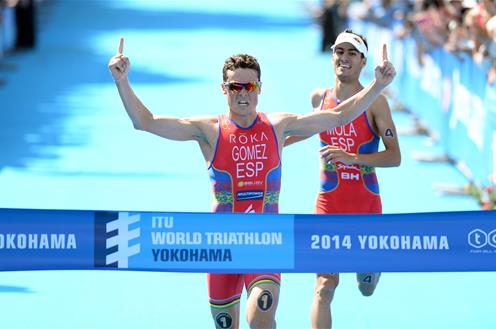 Javier Gómez Noya, campeón del Mundo Triatlón 2014 (Federación Española de Triatlón)An important factor for sporting success is the increase in private contributions as a supplement to public money providing economic support for the present and future.
Javier Gómez Noya, campeón del Mundo Triatlón 2014 (Federación Española de Triatlón)An important factor for sporting success is the increase in private contributions as a supplement to public money providing economic support for the present and future.
In line with the slight improvement in the economy, Spanish sports had a budget in 2014 for the Higher Council for Sport of 80,152,490 euros, an increase of 6.65% on the previous year. A further 6,272,640 euros were allocated to the Spanish Agency for the Protection of Health in Sport.
Royal Decree 1363/2007, of 24 October, establishing the general regulations of special sports education, implemented the provisions of Sports Act 10/1990, of 15 October, and of Constitutional Law 2/2006, of 3 May, on Education, and regulated this type of teaching. The law was drafted with a broad consensus, and aims to provide trainers working in the field with associated training according to the professional profile and functions they carry out.
In addition, the extension of the practice of sport and the development of demand in its different forms, whether or not competitive, justify the need to regulate the teaching of sports techniques in an appropriate educational framework and with the necessary uniformity across the whole country. Against this backdrop, the National Sports Council has enacted various regulations and created official titles for Sports Instructors and Senior Sports Instructors. Consequently, 24 Sports Instructor titles and 20 Senior Sports Instructor titles have been published in 14 sporting fields, as well as the training plans at different levels, drawn up by 39 Spanish sports federations.
In relation to ongoing training plans for sports instructors and trainers, the Spanish sports federations were supported by the Ongoing Sports Training Programme of the National Sports Council (FOCO Programme). During 2015, the Ongoing Sports Training Programme was regulated for the period 2015-2017, establishing the conditions for the inclusion of continuous training activities organised by the Spanish sports federations. The following federations took part in this: Spanish Federation of Olympic Wresting and Associated Disciplines, the Spanish Padel Tennis Federation, The Royal Spanish Swimming Federation, the Royal Spanish Equestrian Federation, the Spanish Triathlon Federation, the Spanish Fencing Federation, the Spanish Caving Federation, the Spanish Boxing Federation and the Royal Spanish Gymnastics Federation. A total of 65 continuous training activities were carried out in total.
Furthermore, in 2015, the creation of CESED (Higher Centre for Sports Training) was approved by Royal Decree 950/2015, of 23 October, together with its implementing structural and operational regulations as a higher centre for sports training with the aim of training high performance sports instructors by offering higher level cycles of sports training. This form of flexible distance learning caters for the special demands of the sports sector. The centre also seeks to offer support to the Spanish sports federations in developing their training offer as well as operating as a benchmark centre in accreditation procedures for professional skills not listed under the National List of Qualifications.
Among the measures for the reform of the public administration services planned in the report by the Commission for Public Administration Reform (CORA), the prior authorisation required for sports training activities promoted by Spanish or regional sports federations has been removed through Order ECD/158/2014, of 5 February, regulating the curricular aspects, general requirements and effects of the sports training activities referred to in the First Transitional Provision of Royal Decree 1363/2007, of 24 October.
Also of note within the scope of CORA is the modification introduced by Law 15/2014, of 16 September, on streamlining the public sector and other administrative reform measures, in Article 32.4 of the Sports Act 10/1990, relating to the system for issuing sports licences. This change, which will enter into force on 1 July 2015, allows the holders of sports licences to participate in any official competition, whatever its territorial scope, provided that they comply with the specific requirements in each case. This measure will make a decisive contribution to extending the principle of market unity in the area of non-professional sports, as it will eliminate overlaps and reduce the administrative procedures needed to take part in sports. In addition, there are other advantages directly derived from this removal of paperwork: the processing of licences of sportspersons, umpires, referees and clubs will be simplified; the geographical mobility of sportspersons will be improved so they can participate in competitions in autonomous regions other than those where they live; and the costs associated with obtaining licences will be reduced.
The Higher Council for Sport has been implementing its own plan of action through the "Women and Sport" unit, designed to achieve the full integration of women in sport. To do so, there has been an increase in the budgetary provision (1,000,000 euros) for this unit. Actions by sports federations have been subsidised with the aim of promoting, facilitating and increasing female participation at all levels of sport (licences, training, elite sportswomen, technical teams, management, administration, social assistance...) in addition to the activity carried out so far by the federations through their general sports programmes. To be eligible for this aid, the Spanish Sports Federations have to meet a series of specific requirements, including two important new ones:
- There have to be three women or 33% female members of the governing board or similar representative body.
- The governing board or similar representative body must establish and approve a protocol for the prevention, detection and action to combat sexual harassment and abuse.
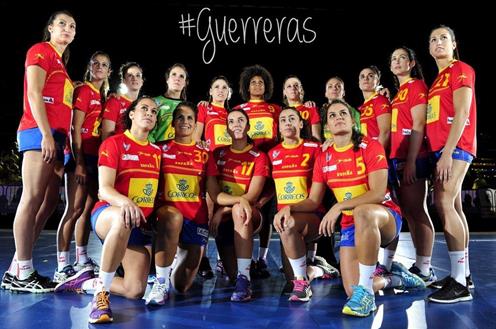 Selección femenina balonmano, plata en el Europeo 2014 (Real Federación Española de Balonmano)These two measures have proved a success. Following the call for subsidy applications, the proportion of women on the governing boards has increased from 15% to 25% and all the federations who requested have subscribed the protocol. Another point worth highlighting is the opening of a special "social assistance" line for sportswomen, including aid for studies, childbirth or maternity. In 2014, 77% of the Spanish Sports Federations benefited by aid from the Women and Sport unit.
Selección femenina balonmano, plata en el Europeo 2014 (Real Federación Española de Balonmano)These two measures have proved a success. Following the call for subsidy applications, the proportion of women on the governing boards has increased from 15% to 25% and all the federations who requested have subscribed the protocol. Another point worth highlighting is the opening of a special "social assistance" line for sportswomen, including aid for studies, childbirth or maternity. In 2014, 77% of the Spanish Sports Federations benefited by aid from the Women and Sport unit.
In addition, there has been participation in the development of the Strategic Equal Opportunities Plan (Spanish acronym: PEIO) 2013-2016, together with the Ministry of Health, Social Services and Equality, particularly with respect to the measures included in Core Element 6.2 "Promote Equality in Physical Activity and Sport".
At the same time, a set of actions has been implemented, including the creation of a twitter account (@myd_csd), the restructuring of the Women and Sport website, the boost provided by an agreement with the Institute for Women's Affairs, publication of the Women and Sport Newsletters and support for actions in various areas.
With respect to the practice of physical activity and sport as an essential element for a healthy lifestyle, the Comprehensive Plan for Physical Activity and Sport (Plan A+D), includes measures and activities to promote sport in all social sectors, in particular among children and young people, make people aware of the benefits of physical activity, and avoid a sedentary lifestyle. Given the enormous economic and social impact of the lack of physical activity (a sedentary lifestyle is the second major cause of death by non-communicable diseases), these measures are carried out in coordination with various ministerial departments, particularly the Ministry of Health, Social Services and Equality.
With the enactment of Sports Act 10/1990, of 15 October, and subsequent experience, Spain has become an international benchmark for the design of comprehensive security policies for large-scale sporting events. However, it appeared to be necessary to extend the legal penalties and actions supporting fair play and condemning violence, racism, xenophobia and intolerance. One result of the legislative initiatives adopted by the government between 2004 and 2008 was Law 19/2007, of 11 July, to combat violence, racism, xenophobia and intolerance in sport.
In addition, one of the indicators of a country's sporting level is its involvement in care for the health of its sportspersons. Following the enactment of Constitutional Law 7/2006, of 21 November, on the protection of health and the fight against doping in sport, scientific and technical support studies were set up to ensure that the health impact on sportspeople subject to high levels of training should be minimal. The Higher Council for Sport's Centre for Sports Medicine takes care of the medical and sports monitoring of elite Spanish athletes, giving them medical and scientific support. This support is extended throughout the country through the different Sports Medicine Centres of the autonomous regions, which reflect the excellent level of this speciality in Spain.
Control of doping is one of the aspects of sport in which Spain is a pioneering country. Since 1963 it has taken part in all the international forums where this subject has been debated. One of the most prestigious doping control laboratories in the world is located in Madrid, and it was one of the first in Europe to achieve accreditation from the International Olympic Committee. Following a firm zero-tolerance policy towards doping, Constitutional Law 7/2006, of 21 November, on protecting health and combating doping in sport was approved in 2006 (known as the Anti-Doping Act). It defines these practices as subject to criminal proceedings for sportspersons.
In 2014, the Spanish Agency for the Protection of Health in Sport (Spanish acronym: AEPSAD) collected a total of 3,916 samples, 824 outside competition and 3,092 in various national competitions. Of these, 3,793 were urine and 123 blood samples. There are also specialised laboratories at work in Spain to detect new substances as they appear.
The new Constitutional Law 3/2013, of 20 June, protecting the health of sportspeople and combating doping in sport, entered into force on 12 July 2013. It constitutes a clear commitment towards modernising the previous regulation. This law represents an advance in the conception of protecting the health of sportspeople, while tackling the fight against doping from a comprehensive perspective as a further element within the system of protecting the health of sportspersons.
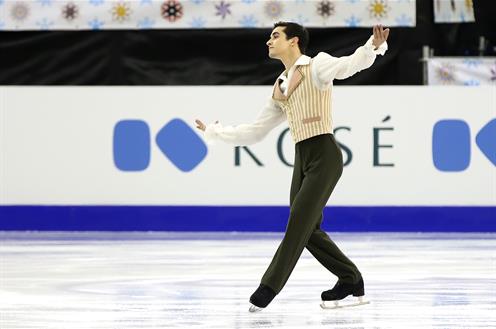 Javier Fernández, oro en el europeo y bronce en el mundial de 2014 (Federación Española de Deportes de Hielo)Constitutional Law 3/2013 introduced modifications in the organisation of the General State Administration in the area of the fight against doping and protection of health in sport, by creating a new body, the Spanish Agency for the Protection of Health in Sport, which will combine the different competences that the system designed under Constitutional Law 7/2006 divided between different entities.
Javier Fernández, oro en el europeo y bronce en el mundial de 2014 (Federación Española de Deportes de Hielo)Constitutional Law 3/2013 introduced modifications in the organisation of the General State Administration in the area of the fight against doping and protection of health in sport, by creating a new body, the Spanish Agency for the Protection of Health in Sport, which will combine the different competences that the system designed under Constitutional Law 7/2006 divided between different entities.
On the international front, the Higher Council for Sport in Spain and the Spanish Agency for the Protection of Health in Sport, each within their respective competences, participate actively in meetings, decisions and agreements within the European Union, the Council of Europe, the United Nations and UNESCO, and the World Anti-Doping Agency.
The Spanish Agency for the Protection of Health in Sport is collaborating with the World Anti-Doping Agency (WADA-AMA) to reform Constitutional Law 3/2013, of 20 June, on the protection of the health of sportspeople and the fight against doping in sport, and to adapt it fully to the new 2015 World Anti-Doping Code, which entered into force on 1 January 2015.
Finally, the new legislation in 2014 in the area of sport included the creation of the Administrative Court for Sport (regulated by Royal Decree 53/2014, of 31 January). This joint national body, which is part of the Higher Council for Sport, has taken on functions including those that were carried out to date by the Spanish Committee on Sport Discipline and the Board for Election Guarantees.
Organisation of sport events
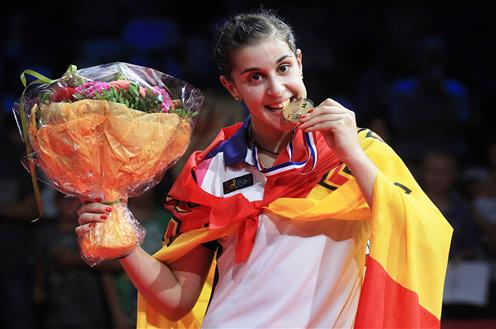 Carolina Marín, Campeona del Mundo Bádminton 2014 (Federación Española de Bádminton)
Carolina Marín, Campeona del Mundo Bádminton 2014 (Federación Española de Bádminton)
In 2015, more than 70 international events were organised at the level of World Championships, European Championships and World Cups.
Particularly noteworthy were the World Ice Hockey Championships (Jaca, Huesca), the Snowboard World Cup (Alp, Girona), the Trampoline World Cup (Valladolid), the European under-18s Field Hockey European Championships (Santander), the Olympic Field Hockey Qualifying semi-finals (Valencia), the Karate Intercontinental Cup (Madrid), the Mountain Bike European Championships (Zegama, Guipúzcoa), the X-TRIAL World Championships (Barcelona and Oviedo), the European Cup at Race Walking (Murcia), the F1 Spanish Grand Prix (Montmeló, Barcelona), the Beach Handball European Championships (Lloret de Mar, Girona), the Women's American Football European Championships (Maracena, Granada), the Padel Tennis World Championships (Malaga), the Moto GP World Championships (Montmeló, Barcelona), the Slalom Word Cup (Seu d'Urgel, Lérida), the Archery World Championships (Las Gabias, Granada), the Duathlon European Championships (Alcobendas, Madrid), the Triathlon European Championships (Reinosa, Cantabria), the Windsurf World Championships (Santa Lucia de Tirajana, Las Palmas) and the Adaptive Sailing Championships (Valencia).
The capacity for organising events at the highest level is increasingly a decisive factor in defining the sporting category of a country.
Links
- National Library of Spain





